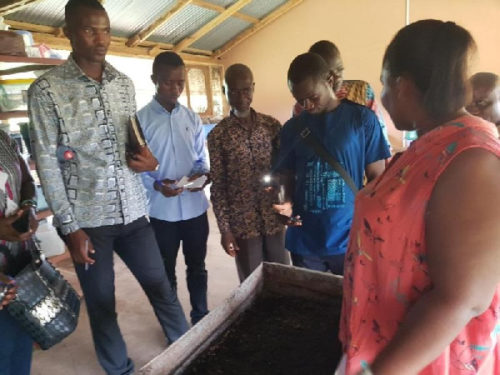
Researchers at the Animal Research Institute of the Council for Scientific and Industrial Research (CSIR-ARI) have begun a comparative study into the use of various feed sources for poultry production to ascertain the best one for growth.
Over the next eight weeks, the researchers would observe 720 chicks, in the area of feeding.
Divided into four groups of 180 each, the first set of birds would be fed on vegetable diet of only soya bean plus synthetic amino acids for balance, while the second set would be on soya bean and fish meal.
The third group has the fish component replaced with housefly larvae with the last group on black soldier fly larvae.
The use of insects as a sustainable, alternative source of protein in animal feed has gained recognition in recent years with research suggesting that larvae meal, as an alternative source of protein to feed livestock, is safe and cost-effective.
Briefing a team of agricultural Officers and farmers from the Greater Accra Region visited the insectary at the ARI, Mr Siegfried Affedzie Obresi, the lead researcher, said the move to compare the different feed sources was to learn, which one gave the best growth for farmers to use in their production.
The team of agricultural Officers and farmers were at the in sectary of the ARI, where the soldier fly and housefly larvae were raised and processed into feed and the brooder house, where the birds were being fed with the different feed components.
The aim was to give them first hand information on the project and to involve them at every stage as the birds were being fed with the different protein sources.
He said the chicks were weighed every week and their weight recorded to see at first hand, which of the groups were gaining weight or otherwise.
The project a collaborative work under the “Insect Feed for West Africa,” is being undertaken by the CSIR-ARI under the auspices of the Centre for Agriculture and Biosciences Internationa1 (CABI) and the Sustainable Agricultural Intensification Research and Learning in Africa (SAIRLA).
Mr Obresi said IFWA’s role was to develop the technology and transfer same to local farmers so they could use waste generated at the household level to feed their livestock.
“So, if they can use the insect in meat production at cheaper prices and create a more sustainable green environment, then, it is good,” he said. The Nutritionist on the IFWA project, Mr Adu Aboagye, said the birds were being given a starter diet of between 22-23 per cent and were being fed 24 hours daily.
“Ideally, we should give them one-hour darkness in case there is power outage they do not kill themselves. Now, the feed is well-balanced and if your feed meets the nutrient requirement of the bird at an age, they do not scramble for food,” he said.
On his part, Dr Victor Attuquaye Clottey, the West Africa Regional Coordinator of CABI, said insect larvae was gaining ground globally as an alternative source of protein and Ghana should not be left behind in its use.
He noted that a large percentage of feed was from fish meal and soya bean cake, which prices were on the increase and there was the need to turn attention to insect larvae, which had high percentage of protein.
Source: GNA




